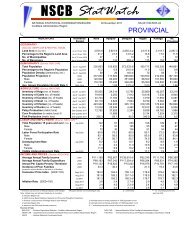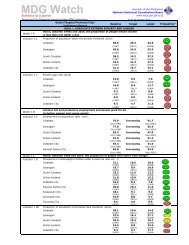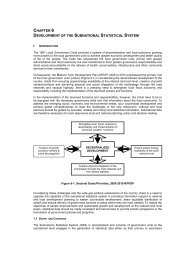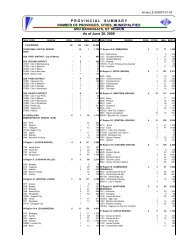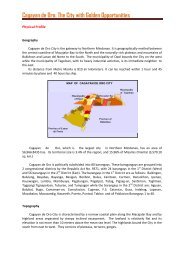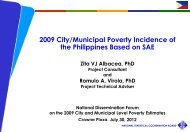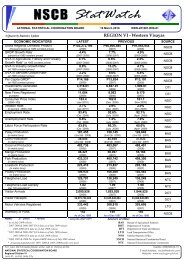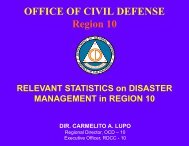Accumulation of Mercury and Other Heavy Metals in Some ... - NSCB
Accumulation of Mercury and Other Heavy Metals in Some ... - NSCB
Accumulation of Mercury and Other Heavy Metals in Some ... - NSCB
You also want an ePaper? Increase the reach of your titles
YUMPU automatically turns print PDFs into web optimized ePapers that Google loves.
9 th National Convention on Statistics (NCS)EDSA Shangri-La HotelOctober 4-5, 2004<strong>Accumulation</strong> <strong>of</strong> <strong>Mercury</strong> <strong>and</strong> <strong>Other</strong> <strong>Heavy</strong> <strong>Metals</strong> <strong>in</strong> <strong>Some</strong>Edible Mar<strong>in</strong>e Mollusks <strong>in</strong> Sibutad, Zamboanga del NortebyGeorg<strong>in</strong>a Lacastesantos - Fern<strong>and</strong>ezFor additional <strong>in</strong>formation, please contact:Author’s name:Georg<strong>in</strong>a Lacastesantos - Fern<strong>and</strong>ezDesignation:Ecosystems Management Specialist IIAgency:PAWCZMS, Department <strong>of</strong> Environment <strong>and</strong> NaturalResources Region IXAddress:PAWCZMS, DENR-IX, Lantawan, Zamboanga CityTelephone: (062) 985-0445Facsimile: (062) 985-0445; 991-1424E-mail:G<strong>in</strong>azambo9@yahoo.com
<strong>Accumulation</strong> <strong>of</strong> <strong>Mercury</strong> <strong>and</strong> <strong>Other</strong> <strong>Heavy</strong> <strong>Metals</strong> <strong>in</strong> <strong>Some</strong>Edible Mar<strong>in</strong>e Mollusks <strong>in</strong> Sibutad, Zamboanga del NortebyGeorg<strong>in</strong>a Lacastesantos - Fern<strong>and</strong>ez 1ABSTRACTThis study was conducted to assess the impact <strong>of</strong> gold m<strong>in</strong><strong>in</strong>g activitieson the nearby mar<strong>in</strong>e bay. We <strong>in</strong>vestigated the fate <strong>of</strong> mercury (hg) among thedifferent environmental compartments (water, sediment, suspended particulates,organisms) <strong>and</strong> its relative distribution among 10 <strong>of</strong> the most common<strong>in</strong>vertebrate species found <strong>in</strong> the bay.Sampl<strong>in</strong>g was done from October 25-29, 1999 <strong>in</strong> 10 sampl<strong>in</strong>g stationswith<strong>in</strong> the bay. Samples were kept frozen <strong>and</strong> later analyzed at the BiologyLaboratory <strong>of</strong> the University <strong>of</strong> Antwerp, Belgium. The mercury discussed <strong>in</strong> thispaper relates to total mercury only.Results <strong>of</strong> analyses showed that all the sampl<strong>in</strong>g sites <strong>in</strong> the bayexceeded the allowable Hg limit for seawater (2ppb). Stations nearest <strong>in</strong>proximity to the m<strong>in</strong><strong>in</strong>g area tend to acquire higher concentrations <strong>in</strong> all thecompartments. Among the species, Modiolus philipp<strong>in</strong>arum, Nerita planospira<strong>and</strong> Trachycardium flavum were with<strong>in</strong> the allowable limit <strong>of</strong> 0.5 ppm. Tectusfenestratus, Strombus sp, Placuna ephippium <strong>and</strong> Circe scripta had as much asa factor <strong>of</strong> 5 more than the allowable limit. From regression analysis, this studyhas shown that mercury concentration <strong>in</strong> tissues <strong>of</strong> 3 out <strong>of</strong> 4 species studiedcorrelated with dissolved mercury <strong>and</strong> suspended particles or sediments. Lack<strong>of</strong> consistent correlations between dissolved or particulate Hg <strong>and</strong> tissueconcentrations were observed <strong>in</strong> Modiolus philipp<strong>in</strong>arum (a bivalve) though itshowed high levels <strong>of</strong> mercury.This study has shown that there are some <strong>in</strong>teractions/associationsamong metals dur<strong>in</strong>g accumulation process <strong>in</strong> several species. However, wewere not able to establish the mechanism that control these<strong>in</strong>teraction/associations.I. Introduction<strong>Heavy</strong> metals such as mercury, lead, arsenic, cadmium, t<strong>in</strong>, chromium,z<strong>in</strong>c, <strong>and</strong> copper are among the most dangerous pollutants <strong>in</strong> the mar<strong>in</strong>eenvironment (Goldberg, 1975; Philips, 1980; Cossa, 1988; Ross, 1988;Schuhmacher <strong>and</strong> Dom<strong>in</strong>go, 1996; Nebel <strong>and</strong> Wright, 1996). Due to its uniqueproperties, mercury is used <strong>in</strong> medical <strong>and</strong> scientific <strong>in</strong>struments likethermometers, manometers <strong>and</strong> barometers, jewelry mak<strong>in</strong>g, for coat<strong>in</strong>g the back<strong>of</strong> mirrors, <strong>in</strong> dental amalgams, as catalyst <strong>in</strong> the production <strong>of</strong> polyurethanefoams, <strong>in</strong> pr<strong>in</strong>t<strong>in</strong>g <strong>and</strong> <strong>in</strong> the extraction <strong>of</strong> gold <strong>and</strong> silver (Dugan, 1972; Sittig,1980; Bunce, 1991; Huber, 1997; STAO, 1992; USEPA, 1997; ATSDR, 1999).<strong>Mercury</strong> cycles <strong>in</strong> the environment as a result <strong>of</strong> natural processes such asvolatilization <strong>of</strong> mercury <strong>in</strong> mar<strong>in</strong>e <strong>and</strong> aquatic environments, from vegetation,degass<strong>in</strong>g <strong>of</strong> geologic materials <strong>and</strong> volcanic emissions <strong>and</strong> anthropogenicactivities, dom<strong>in</strong>ated by <strong>in</strong>dustrial processes <strong>and</strong> combustion sources (T<strong>in</strong>ggi <strong>and</strong>Craven, 1996; Park <strong>and</strong> Curtis, 1997). Most <strong>of</strong> the mercury <strong>in</strong> the atmosphere is1 Ecosystems Management Specialist II, PAWCZMS, DENR-IX, Zamboanga Pen<strong>in</strong>sula.
are fit for human consumption. Though the study <strong>in</strong>cludes a wide range <strong>of</strong> heavymetals, emphasis is on mercury ma<strong>in</strong>ly because it is specially used <strong>in</strong> the goldm<strong>in</strong><strong>in</strong>g process. In addition mercury is <strong>of</strong> special <strong>in</strong>terest due to its toxicity tohumans. The mercury discussed <strong>in</strong> this paper relates to total mercury only.III.Study AreaMurcielagos is a semi enclosed bay <strong>and</strong> is located 123°33'00'' E longitude<strong>and</strong> 8°39'00'' N latitude. It falls under the adm<strong>in</strong>istrative jurisdiction <strong>of</strong> Regions IX(Western M<strong>in</strong>danao) <strong>and</strong> X (Northern M<strong>in</strong>danao). Sibutad is one <strong>of</strong> themunicipalities under Region IX situated along Murcielagos. The bay isapproximately 6547 ha wide <strong>and</strong> can be reached with motorized boats or bypublic <strong>and</strong> private l<strong>and</strong> transportation. The area was once a graz<strong>in</strong>g l<strong>and</strong> <strong>and</strong>rema<strong>in</strong>ed unproductive <strong>and</strong> neglected until the discovery <strong>of</strong> gold <strong>in</strong> 1987.Gold was discovered <strong>in</strong> two areas <strong>in</strong> the municipality <strong>of</strong> Sibutad namelyLarayan <strong>and</strong> Lalab. This resulted <strong>in</strong> the <strong>in</strong>flux <strong>of</strong> small-scale m<strong>in</strong>ers, panners,gold buyers <strong>and</strong> prospectors. By 1988, it was estimated that around 10000people had moved to the area <strong>and</strong> had occupied 250 ha <strong>of</strong> the 360 ha l<strong>and</strong>available.150 tunnels were built, <strong>and</strong> 139 ball mills were <strong>in</strong>stalled. The averagedaily gold production was 150 m 3 (DENR-IX, 1990). After the peak <strong>of</strong> the m<strong>in</strong><strong>in</strong>gactivity from 1988-1989, only 79 active tunnels rema<strong>in</strong>ed <strong>in</strong> the area with 67 ballmills <strong>and</strong> the average gold production was reduced to only 5 m 3 . In this operation,67 kgs <strong>of</strong> mercury are utilized per day <strong>and</strong> 50 kgs <strong>of</strong> these are monthly wasted.Cyanide is also used for gold extraction through the heap leach<strong>in</strong>g process. Thismethod is utilized by Philex Gold Philipp<strong>in</strong>es Inc., the m<strong>in</strong><strong>in</strong>g firm <strong>in</strong> the area(DENR, 1998).The sampl<strong>in</strong>g sites were chosen to <strong>in</strong>clude stations already established byDENR-IX <strong>and</strong> only Stations 8-10 were added as control po<strong>in</strong>ts. Stations 1-9 fallunder the jurisdiction <strong>of</strong> Region IX while Station 10 belongs to Region X.IV.Sample CollectionSampl<strong>in</strong>g was done from October 25-29, 1999. Both filtered <strong>and</strong> unfilteredseawater samples were collected. A 0.2 µm membrane filter paper (Schleicher<strong>and</strong> Schuell) was used for filtration. The filtered water was collected <strong>in</strong>polypropylene conta<strong>in</strong>ers, 100 ml each <strong>and</strong> 1 ml nitric acid was added. Theseconta<strong>in</strong>ers were kept frozen at -5°C which was the only freezer available <strong>in</strong> thearea.The filters were placed <strong>in</strong> polypropylene tubes <strong>and</strong> kept frozen. Theunfiltered water samples were immediately wrapped with alum<strong>in</strong>um foil to preventany photosynthetic activity <strong>and</strong> were also kept frozen at -5°C.The most common mollusk species that occurred per station wereconsidered <strong>in</strong> this study. Samples were r<strong>and</strong>omly collected with<strong>in</strong> a 10 m radius.<strong>Some</strong> were h<strong>and</strong> picked while others required div<strong>in</strong>g. At each station, the twomost dom<strong>in</strong>ant species were collected, 30 specimens each. S<strong>of</strong>t tissues <strong>and</strong>
shells were transferred to separate vials <strong>and</strong> kept frozen. A total <strong>of</strong> 570specimens were gathered <strong>in</strong> the area belong<strong>in</strong>g to six orders <strong>and</strong> ten families.Sediment samples were collected between 0.5 m <strong>and</strong> 1.5 m water depthwith a 52 mm diameter (height = 13 mm) plastic Petri dish. These were filledcompletely <strong>and</strong> tightly sealed with adhesive tape to avoid air spaces. Fivereplicates were gathered for each station <strong>and</strong> kept frozen.To determ<strong>in</strong>e Suspended Particulate Matter (SPM), filters were preweighed<strong>and</strong> a known volume <strong>of</strong> seawater was filtered. Filters were dried at a 110°C oven for a total <strong>of</strong> 3 hours <strong>and</strong> then transferred to a desiccator before tak<strong>in</strong>gthe f<strong>in</strong>al weight. Samples were kept frozen (Hamilton, 1989; Hershelman et al.,1981; Hornung et al., 1981; Joiris et al., 1995; Parker <strong>and</strong> Curtis, 1997) from thetime <strong>of</strong> collection <strong>in</strong> the Philipp<strong>in</strong>es. Water, suspended particles, sediment <strong>and</strong>tissue samples were transferred to a cooler (Igloo) packed with dry ice(O’Connor, 1998) <strong>and</strong> transported to Belgium for analysis.V. Analytical MethodsDissolved organic carbon content <strong>in</strong> filtered seawater were measuredus<strong>in</strong>g a Shimadzu 5000 TOC analyzer while particulate <strong>and</strong> sediment organiccarbon were measured us<strong>in</strong>g the Coulomat carbon analyzer (Coulomat 702-LI,Strohle<strong>in</strong> Labortechnik).For sediments, particle size distribution were determ<strong>in</strong>ed with the use <strong>of</strong> aMastersizer particle analyzer (Mastersizer, Malvern Instruments).An Inductively Coupled Plasma Mass Spectrometer ICP-MS, UltraMass700 (Varian Australia Pty Ltd) was used for metal analysis <strong>in</strong> the differentcompartments: water, organisms <strong>and</strong> sediments.VI.Results <strong>and</strong> DiscussionA. Relationship between metal concentrations <strong>in</strong> the s<strong>of</strong>t tissues <strong>of</strong>organisms <strong>and</strong> concentrations <strong>in</strong> water, suspended particles <strong>and</strong>sediments.Metal concentrations <strong>in</strong> body tissues <strong>of</strong> mollusk <strong>in</strong> the bay were related tometal levels found <strong>in</strong> the three environmental compartments (water, suspendedparticles <strong>and</strong> sediments). Two approaches were applied: (i) simple l<strong>in</strong>earregressions were constructed between metal concentrations <strong>in</strong> the tissues <strong>and</strong>concentrations <strong>in</strong> either water suspended particles or sediments. Theseregressions were performed for four species (T. fenestratus, A. scapha, M.philipp<strong>in</strong>arum <strong>and</strong> Strombidae), which were present at more than three stations.(ii) The second approach was to exam<strong>in</strong>e the relationships further by apply<strong>in</strong>g amulti-l<strong>in</strong>ear regression model with dissolved, suspended particles <strong>and</strong> sedimentmetal concentrations as variables. The model was first applied to <strong>in</strong>dividualspecies for each element <strong>and</strong> later on all the species comb<strong>in</strong>ed. Both regressionanalyses were performed with the computer s<strong>of</strong>tware STATISTICA 6.0.
B. Metal concentrations (dissolved) <strong>in</strong> seawaterB.1 <strong>Mercury</strong> <strong>and</strong> goldIn this section we compared dissolved metal concentrations among the 10sampl<strong>in</strong>g stations. The highest mercury concentration <strong>in</strong> water was observed atStation 1 with 8.91 µg/l <strong>and</strong> Station 6 with 12.29 µg/l. High concentrations werealso noted <strong>in</strong> Stations 3 to 5 (6.32 µg/l, 5.40 µg/l, <strong>and</strong> 7.16 µg/l respectively).Most <strong>of</strong> the stations that showed high mercury concentration also had high goldcontent except for Stations 7 <strong>and</strong> 8 which showed the opposite. Compared withdissolved mercury measured earlier <strong>in</strong> the bay, our results are generally higherby about an order <strong>of</strong> magnitude. It is unlikely that these results are erroneous asthe results for the reference seawater were <strong>in</strong> agreement with certified values.Such high dissolved mercury concentrations <strong>in</strong> m<strong>in</strong><strong>in</strong>g areas <strong>in</strong> the Philipp<strong>in</strong>esare common. In a study by Williams et al. (1995) <strong>in</strong> a nearby m<strong>in</strong><strong>in</strong>g area <strong>in</strong> theeastern part <strong>of</strong> M<strong>in</strong>danao (Philipp<strong>in</strong>es), dissolved mercury ranged between 0.21 -2906 µg/l with<strong>in</strong> 1 km from the m<strong>in</strong>e fields, <strong>and</strong> samples taken distant from thesite showed concentration range <strong>of</strong> 0.14 µg/l <strong>and</strong> 2.84 µg/l. These values arecomparable to our study area. A year later Breward (1996) did a follow-up studyfrom Mamunga River, near the m<strong>in</strong><strong>in</strong>g camp <strong>and</strong> noted a maximum Hgconcentration <strong>of</strong> 1.539 µg/l. When compared with other parts <strong>of</strong> the world, ourresults are higher than what is reported by Kannan et al. (1998) for estuaries <strong>in</strong>South Florida but lower than <strong>in</strong> the coastal waters <strong>of</strong> North Lebanon (Shiber etal., 1978).B.2 <strong>Other</strong> metalsFor most <strong>of</strong> the other metals, Station 4 showed the highest concentration(715.41 µg/l for Al (122 µg/l), Fe (63.8 µg/l), Mn (38.9 µg/l), Zn (51µg/l) except fornickel which was highest <strong>in</strong> Station 7 (27.44 µg/l).C. <strong>Heavy</strong> metal concentrations <strong>in</strong> suspended particlesC.1 <strong>Mercury</strong> <strong>and</strong> gold<strong>Mercury</strong> <strong>and</strong> gold concentrations measured <strong>in</strong> the bay ranged between 3 -13 µg Hg/g <strong>and</strong> 1 - 6 µg Au/g dry weight, respectively. The highest mercury <strong>and</strong>gold concentrations were recorded at Station 4. <strong>Other</strong> stations, which showedhigh Hg <strong>and</strong> Au concentrations, were Stations 1, 2 <strong>and</strong> 5. These were stationslocated <strong>in</strong> the proximity <strong>of</strong> the m<strong>in</strong><strong>in</strong>g area. When tested to see whether therewere significant differences among all stations, the results from Kruskal-Wallistest showed very high significant differences (P < 0.001) all stations comb<strong>in</strong>ed.C.2 <strong>Other</strong> metals<strong>Other</strong> metals such as Cd, Co, Cu, Fe, Ni, Pb, <strong>and</strong> Zn were highest <strong>in</strong>Station 4 while Ag <strong>and</strong> Cr, which were highest <strong>in</strong> Station 6. There are few studieson metal concentrations <strong>in</strong> suspended particles particularly places close to goldm<strong>in</strong><strong>in</strong>g fields (Tessier et al., 1984, Fileman et al., 1991).
D. Metal concentrations <strong>in</strong> the bottom sedimentsD.1 <strong>Mercury</strong> <strong>and</strong> goldSediments serve as s<strong>in</strong>ks for heavy metals <strong>and</strong> for metals with high aff<strong>in</strong>ityfor organic particles such as mercury will be elevated <strong>in</strong> organic rich sediments(Skei, 1978; Luoma, 1989). Generally, as gra<strong>in</strong> size decreases, the concentration<strong>of</strong> metals adsorbed onto sediments <strong>in</strong>creases, particularly across the transitionzone from silt to clay (< 4 – 63 µm) (Deely et al., 1992). Except for Station 8,which exhibited the highest Hg <strong>and</strong> Au contents (58.15 µg/g & 254.29 µg/grespectively), most <strong>of</strong> the stations with smaller particle size showed higherconcentrations for Hg <strong>and</strong> Au. Gold was also highest (254.3 µg/g) at station 8followed by station 4 (21.4 µg/g).Stations 2, 9 <strong>and</strong> 10 also serve as monitor<strong>in</strong>g stations for neighbor<strong>in</strong>gregion (DENR-X) <strong>and</strong> the results they obta<strong>in</strong>ed for their June 1999 sampl<strong>in</strong>g(Manzano <strong>and</strong> Daitia, 1999) were about two orders <strong>of</strong> magnitude higher than ourOctober samples. This difference may be a result <strong>of</strong> differences <strong>in</strong> procedures forthe extraction <strong>of</strong> total metals from the sediments used. In our study, total metalconcentrations <strong>in</strong> the sediments were measured accord<strong>in</strong>g to the procedurereported by Tessier et al. (1979) <strong>and</strong> Bervoets et al. (1998). <strong>Mercury</strong> <strong>in</strong> riversediments from Eastern M<strong>in</strong>danao (Williams et al., 1995) was <strong>in</strong> the range <strong>of</strong> 0.02mg/kg <strong>and</strong> 23 mg/kg with<strong>in</strong> the m<strong>in</strong><strong>in</strong>g site, five times higher than what this studymeasured. Compared with other studies Sasamal et al. (1987), Craig <strong>and</strong>Moreton (1983), Park <strong>and</strong> Curtis (1997) recorded similar values.D.2 <strong>Other</strong> metalsEven for the other metals, Station 8 had the highest concentration, exceptfor lead which was high <strong>in</strong> Station 4 (331 µg/g) <strong>and</strong> Station 5 (286 µg/g). Hamilton(1989) reported similar concentrations for cadmium <strong>in</strong> the Northeast Pacific.E. <strong>Heavy</strong> metal concentrations <strong>in</strong> <strong>in</strong>vertebrate species <strong>in</strong> the bayFrom the total <strong>of</strong> 10 species collected dur<strong>in</strong>g our sampl<strong>in</strong>g exercise, onlyfour species were present <strong>in</strong> more than 3 stations. The other species were eitherpresent only at one or two stations. Metal concentrations varied from one stationto other <strong>and</strong> with species.E.1 <strong>Mercury</strong> <strong>and</strong> goldAmong the sampled species <strong>in</strong> the bay, Circe scripta <strong>in</strong> Station 2 had thehighest mercury content, 9.2 µg/g, followed by Placuna ephippium also <strong>in</strong> Station2 with 4.32 µg/g, Tectus fenestratus <strong>and</strong> Strombus sp. <strong>in</strong> Station 3 with 3 µg/g<strong>and</strong> 2.74 µg/g respectively. <strong>Other</strong> species that showed high mercuryconcentration <strong>in</strong>clude Tectus fenestratus from Station 2 with 2.72 µg/g; Anadarascapha <strong>in</strong> Station 4 with 1.66 µg/g; <strong>and</strong> Littor<strong>in</strong>a scabra from Station 6 with 1.58µg/g. The rest <strong>of</strong> the species had less than 1 µg/g concentration.
For gold, Isognomon isognomum <strong>in</strong> Station 5 had the highest tissueconcentration, 5.78 µg/g. <strong>Other</strong> species like Modiolus philipp<strong>in</strong>arum <strong>in</strong> Station 10,Isognomon isognomum <strong>in</strong> Station 4, Tectus fenestratus <strong>in</strong> Stations 3 <strong>and</strong> 8showed greater than 1 µg/g. The rest <strong>of</strong> the species <strong>in</strong> various stations had lessthan 1 µg/g.When compar<strong>in</strong>g the results <strong>of</strong> the present study with earlier study byBayaron et al. (1997) it seems that there is a decrease <strong>in</strong> the concentration <strong>of</strong>mercury <strong>in</strong> the mollusc species <strong>in</strong> the area. The highest reported concentrationwas 2.63 µg/g for Mytillus sp., which were collected with<strong>in</strong> Station 4 <strong>of</strong> thepresent study. The result we obta<strong>in</strong>ed from other bivalves collected <strong>in</strong> Station 4had on the average 1.16 µg/g. These results are outside the st<strong>and</strong>ards set by thePhilipp<strong>in</strong>e government (0.5 µg/g). However, results from this study arecomparable with other studies elsewhere (Denton <strong>and</strong> Breck, 1981; Meyer et al.,1998, Williams et al., 1999).E.2 <strong>Other</strong> metalsThe follow<strong>in</strong>g species were observed to have high concentrations for theother metals considered <strong>in</strong> this study: Circe scripta <strong>in</strong> Station 2 for Ag <strong>and</strong> Co;Placuna ephippium <strong>in</strong> Station 2 for Cd; Isognomon isognomum <strong>in</strong> Stations 4 forCu; Tectus fenestratus <strong>in</strong> Stations 2 <strong>and</strong> 3 for Cr <strong>and</strong> Fe respectively; Neritaplanospira for Ni <strong>and</strong> Littor<strong>in</strong>a scabra for Pb all <strong>in</strong> Station 6; <strong>and</strong> Isognomonisognomum <strong>in</strong> Station 4 for Zn.These results for Ni <strong>and</strong> Cd are comparable to other studies by Paez-Osuna et al. (1991) while Zn was three times lower than reported by Lopez et al.(1990). Lobel et al. (1982) reported much higher concentration <strong>of</strong> Cu compared tothose found <strong>in</strong> all the gastropods studied <strong>in</strong> the bay. His group also found higherFe content compared to what was detected <strong>in</strong> Tectus fenestratus, which comesfrom the same order but Zn was comparable to what was measured <strong>in</strong> this studyfor Modiolus philipp<strong>in</strong>arum which comes from the same genus.F. Are metal concentrations <strong>in</strong> organisms correlated with levelsmeasured <strong>in</strong> water, suspended particles or sediments?In our study we used l<strong>in</strong>ear regression analysis to determ<strong>in</strong>e the fraction <strong>of</strong>metal measured <strong>in</strong> four mollusk species that can be described by levels found <strong>in</strong>the three compartments (water, suspended particles <strong>and</strong> sediments).F.1 Total <strong>Mercury</strong><strong>Mercury</strong> tissue concentration showed a l<strong>in</strong>ear relationship with all threecompartments <strong>in</strong> only one species (T. fenestratus). There were also significantl<strong>in</strong>ear relationships between tissue concentrations <strong>in</strong> A. scapha <strong>and</strong> suspendedparticles <strong>and</strong> sediments. However, l<strong>in</strong>ear regression models found relationshipsbetween tissue concentrations <strong>and</strong> all three compartments except for A. scapha<strong>and</strong> with sediments for M. philipp<strong>in</strong>arum <strong>and</strong> Strombus sp. It is <strong>of</strong>ten reported thatmetal concentrations <strong>in</strong> tissues <strong>of</strong> many mollusk species reflects levels found <strong>in</strong>the environment (Goldberg, 1975; Philips, 1976; Cossa, 1988; Fowler, 1990).
Consequently, l<strong>in</strong>ear relationships between environmental <strong>and</strong> tissue metalconcentrations are usually expected with<strong>in</strong> a certa<strong>in</strong> range. But beyond a certa<strong>in</strong>environmental concentration, metals <strong>in</strong> tissues <strong>of</strong> organisms tend to reachasymptotic level (Pentreath, 1973; Riisgard et al., 1997; Wang et al., 1997). Inaddition, this relationship can be modified by a variety <strong>of</strong> environmental <strong>and</strong>physiological factors such as sal<strong>in</strong>ity, metal speciation, physiological conditionbody size, sex, species, tidal position <strong>and</strong> season (Philips, 1997; De Kock <strong>and</strong>Kramer, 1994; Fisher et al., 1996; Vercauteren <strong>and</strong> Blust, 1996; Muhaya et al.,1997).When a multiple l<strong>in</strong>ear regression model was applied to mercuryconcentrations <strong>in</strong> all the species (10) studied, we observed significant correlationrelationship with dissolved mercury <strong>and</strong> suspended particles (p
imply<strong>in</strong>g that dissolved gold is relatively more important for accumulation <strong>in</strong> theorganism.F.3 <strong>Other</strong> metalsGenerally, for all the dissolved metals measured there were significantcorrelations with tissue metal concentrations. However the variances that couldbe expla<strong>in</strong>ed by dissolved fraction were generally low (
factor <strong>of</strong> 5 more than the allowable limit. Stations 1, 7-9 had organisms just belowthe tolerable concentration among the stations.From regression analysis, this study has shown that mercuryconcentration <strong>in</strong> tissues <strong>of</strong> 3 out <strong>of</strong> 4 species studied correlated with dissolvedmercury <strong>and</strong> suspended particles, <strong>and</strong> no correlations were observed with eithersuspended particles or sediments.VIII.RecommendationPeople liv<strong>in</strong>g around Murcielagos bay depend so much on the seafood <strong>in</strong>the area for their daily subsistence <strong>and</strong> consider<strong>in</strong>g the effects <strong>of</strong> metalconcentrations such as mercury obta<strong>in</strong>ed from this study, it appears that suchdependence pose a great risk.It is perceived that the f<strong>in</strong>d<strong>in</strong>gs <strong>of</strong> this study will enable both the DENRtogether with the Local Government <strong>of</strong> Sibutad <strong>and</strong> the prov<strong>in</strong>ce <strong>of</strong> Zamboangadel Norte, to come up with safety measures for the coastal residents <strong>and</strong> thesmall-scale m<strong>in</strong>ers for better management <strong>of</strong> the bay.



